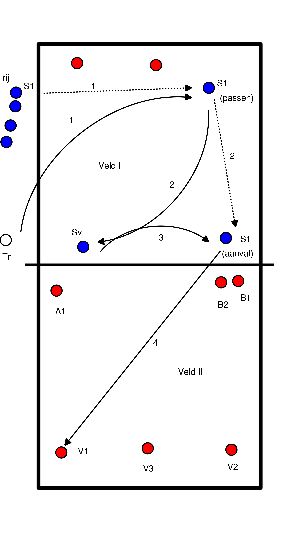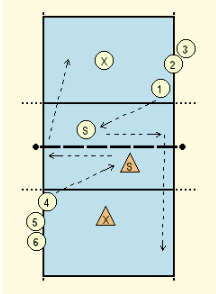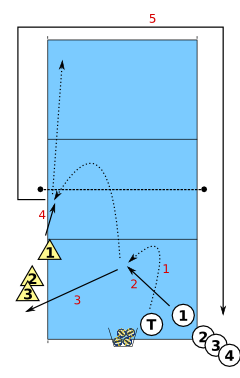Volleyball drills for technique attack / smash / spike / hitting
- free ball is brought in by reception player
- then the pass is given
- and the attacker attacks in a defined zone.
- Point system:
- out: -1,
- net: -1,
- in: 0,
- inside the box: +2
Warming up / all-round training
Each player will pass, attack, distribute, block, defend, rally, with turnovers.
#2 means
- Trainer stands with cart with balls at the pole at #2 (position 2)
- Players stand outside the field at the side of #1 and a playmaker at # 2/3
- First round starts with Trainer throwing the ball to #5, player 1 runs from the sideline to the ball and plays it to the distributor.
- Start with "blue players" (see drawing), then extend with "red players
Further course of play:
- Tr throws ball for S1 to #5
- S1 runs in and plays to Sv (#2/3)
- Sv gives setup to the outside (#4)
- S1 attacks.
- Turn over: S1 becomes Sv, Sv gets the ball and joins the line at #1.
Expansion 1
- Sv turns to the other side of the net and becomes a blocker.
Now the same steps as above, but with the block opposite the attacker. - Turn over: S1 (has just attacked) becomes Sv at #2/3, Sv
passes under the net and becomes B1 at #2B1
who, after blocking, goes to get the ball and joins the row.
Extend 2
- After blocking at #2, player goes to defend at #5. Attacker is obliged to pass to #5.
- When the ball is defended a rally may be played (2 vs. 2)
- After end of rally or no defence or fault in attack, turn over
Extend 3 and more
- One can extend with a 2nd blocker, 2nd and 3rd defender (on resp. #1 and #6)
- More players can be added to field I (so players from the sideline move in when a rally arises)
- The passing game becomes S1 (passing and attacking) -> Sv -> B1 (#3) -> B2 (#2) -> V1 (#1) -> V2 (#6) -> V3 (#5) possibly A2 (#4) and then connect again.
- You can expand to 6 against 6, so start with blue, then B1, then B2, then V1, then V2 (when continuing the game, first V2 and then V1), then V3 (continuing the game with V2, V3, V1) and then possibly A1. In the meantime, players in field I must be added.
- If there are several players in Area I, you can choose to throw in a ball on S1 at #5 instead of throwing in a ball through Tr.


- The purpose of the exercise is twofold:
- the defender must learn to "read" where the attacker is going to hit
- and the attacker has to see where the defence stands before hitting.
- We work with two regular playmakers, on both sides of the field a row of attackers on the left-for position.
- And two defenders, who may choose where they position themselves on the field.
- A defender has to defend the attack 10 times, preferably a nice pass, but touching is enough.
- If the attacker hits the net or leaves the field, that also counts.
- And the attackers may only smash, no prick balls!
- After the attack, the attacker retrieves the ball and joins the other line.
- When the defender has defended a ball 7 times, he changes with an attacker.
- If there are less players, the exercise can also be done, but then on one side.
- The attacker retrieves the ball and then joins the same line.
- The blocking player joins in and indicates where he is going to block and the mid-back goes to his place.
Making an attack run:
- Right handed: left, right, left
- Left handed: right, left, right
- jump with your arms
- Hit with your belly
Pass
- Line up attackers on the outside, pay attention to the run-up and the arms.
- Row of attackers on middle and back
- 3 attackers on position 2, 3, 4 and reserve.
- SV comes in from the back
- in the opposite field 3 blockers on position 2, 3, 4
- at position 6 is a defender
- Trainer throws ball to defender
- defender passes to SV at position 2-3
- SV gives set up at position 2, 3 or 4
- Blockers block and block defence
- attacker gets ball, reserve attacks
- defender changes after 10 good balls
This exercise is about another player taking over the setup.
The players are divided into two groups. One group is lined up in the front left corner ready to attack. The players of the other group line up in the back right of the field.
- The trainer bounces the ball high somewhere in the field (1).
- The player gives a high setup to the outside left (2) and then gets in line at the front left (3).
- The first player on the front left smashes the ball (4) and retrieves it himself in order to join the back row on the right (5).

- three people in the field.
- Coach hits the ball into the field
- then sets it up in three
- over the net
- who plays the ball over the net retrieves it and puts it in the cart.
- 4 players are in the line-up. 1 of the players SV.
- 3 other players serve.
- Perfect pass to SV
- SV plays behind 3 meter line for attack.
- 10 balls change.
- team is in line.
- serve on team
- team builds attack, completes it.
- Coach plays next ball immediately,
- 4x in quick succession.
- Service
- Pass to mid-forward on 2 or 4,
- Attack quickly on 3 or long ball to 4 or 2, or......3 meter attack
- advantage of variation of the playmaker,
- and attack is shifted to other side,
- difficult to defend,
- and mid-forward opponent must defend in the block.
Goal of the exercise:
Fine tuning techniques
Explanation of the exercise:
- From the right front, balls are hit on the own half to position 4 / 5.
- The defender attacks his own ball again.
- Follow your own ball. N
- After your attack you start serving from position 5 straight ahead.
4 game forms for warming-up for youth teams.
Game form 1: ( Korfvolley )
- Theme of the training: Playing above the head
- Explanation:
- A game of Korfball, same rules, but it is only allowed to score with an overhand ball.
- More difficult:
- The ball must be pinned by a team mate.
- Easier:
- Draw a circle around the basket, where only the attacking team is allowed to go.
- Scoring:
- 1 point for every ball scored
- 2 points for a teammate who passes the ball to the attacker.
Game form 2: ( Basketball volleyball )
- Theme of the training: Playing with hands
- Clarification:
- Make 1 group per basket and throw the ball under a left or right angle from under the basket.
- The players have to play the ball underhand in the basket.
- Harder:
- Hit the ball in a controlled way instead of throwing it in.
- Catch the ball before it hits the floor via the basket.
- Easier:
- Throwing the ball straight instead of in an angle.
- Reduce the distance to the basket.
- Point count:
- 1 point for every scored ball
- 2 points for a passed ball
- 3 points if the ball is caught in follow-up.
Game form 3: ( Tennisvolley )
- Theme of the training: attack
- Explanation:
- Tension the net at tennis height and make teams of 3 or 4 players.
- The ball must be played back and forth and smashed into the ground on your own side.
- The receiving side may not let the ball bounce first.
- Turn over every time the ball is played to the other side.
- You will see that this is a very difficult exercise when the ball lane recognition is not in order.
- Harder:
- Jump on attack
- Easier:
- No spin
- Ball may not end within 3 meters
- Point count:
- 1 point for every scored ball
Game form 4: ( Trefvolley )
- Theme of the training: Defence
- Explanation:
- Game of dodgeball where all the defensive techniques of volleyball are allowed as defence.
- Player throws the ball to his opponent, who tries to defend the ball so his teammate can catch it.
- Harder:
- Field must be divided into front and backfield, catching teammate must be in the frontfield.
- Thrown ball must be a batted ball.
- Easier:
- Throw with 2 hands from the neck.
- Throw with 2 hands from the chest.
- Point count:
- 1 point for every ball defended
General:
- The warm-up for youth should be playful and always with the ball.
- Do not warm up too much, stretch, play volleyball immediately.
- On one side of the net there are 6 players. (If they are having trouble with the set up, the trainer can take over this spot).
- The remaining players stand on the other side of the net.
- They start the game, by serving.
- The 6 players build an attack. Pass/Set up/Smash.
- Just play the point.
- Full turn at the smash.
- Communication by calling LOS, good pass.







